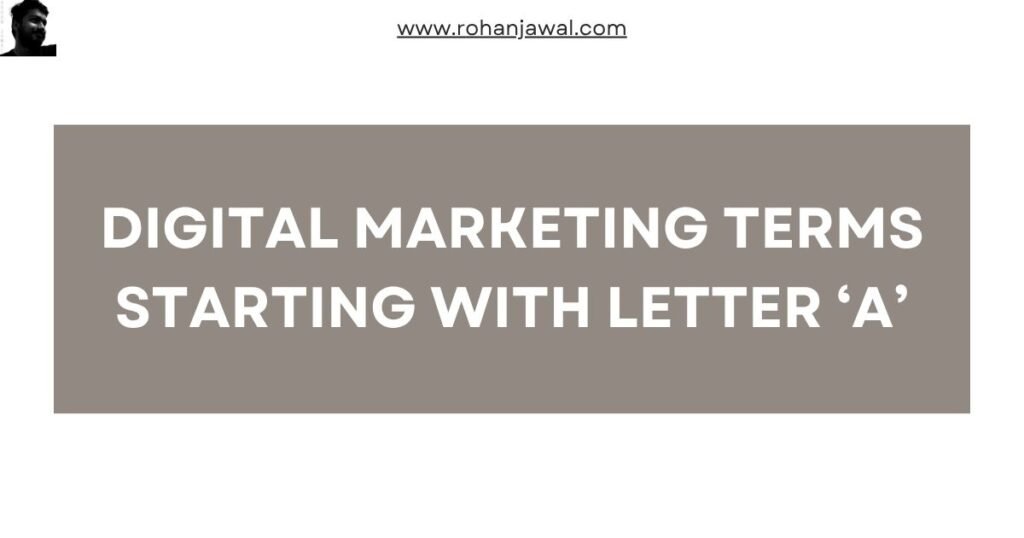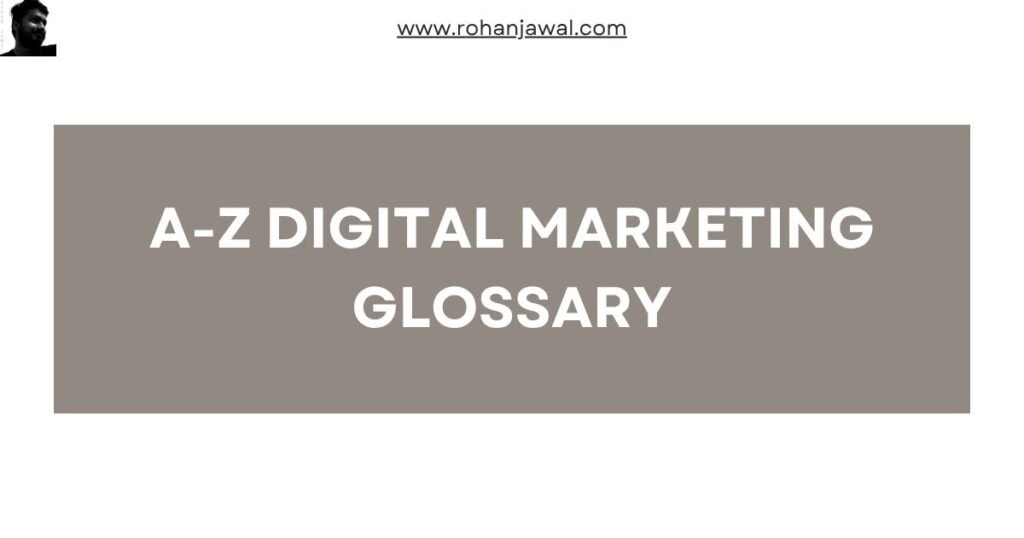Digital marketing is evolving fast, and whether you’re a business owner, marketer, or just starting out, understanding the right terms can make all the difference. In this post, we’re diving into digital marketing terms that start with the letter “A”—from A/B Testing to Augmented Reality Marketing.
Think of it like this: just as the alphabet begins with “A,” many crucial marketing concepts also start here. These are the fundamentals that help brands optimize campaigns, analyze performance, and target the right audience. Let’s break them down in a way that’s easy to grasp—no complex jargon, just simple explanations with real-world examples.
1. A/B Testing
What is A/B Testing?
A method of comparing two versions of a webpage, email, or ad to determine which one performs better based on user engagement and conversions.
Brief Explanation of A/B Testing
Imagine you run a bakery and create two different flyers to attract customers. You distribute each version to different areas and track which one brings in more people. The more effective flyer helps you decide how to market better.
Example of A/B Testing
An e-commerce store tests two product page designs. One has a red “Buy Now” button, and the other has a green one. After testing, they find that the red button gets more clicks, so they implement it across the site.
Related Words to A/B Testing: Conversion rate, split testing, CRO (Conversion Rate Optimization), user behavior
2. Above the Fold
What is Above the Fold?
The portion of a webpage that is visible without scrolling when it first loads.
Brief Explanation of Above the Fold
When you open a newspaper, the headlines and main image on the top half are what you see first. Websites work the same way—important content should be placed “above the fold” so users see it immediately.
Example of Above the Fold
A news website ensures that its top stories and a “Subscribe” button are visible without scrolling to grab user attention.
Related Words to Above the Fold: Web design, UX/UI, first impression, engagement
3. Affiliate Marketing
What is Affiliate Marketing?
A performance-based marketing strategy where an individual (affiliate) earns a commission by promoting another company’s product or service.
Explanation of Affiliate Marketing
Imagine recommending a good restaurant to a friend, and the restaurant gives you a reward for every person you bring in. That’s how affiliate marketing works in digital marketing.
Example of Affiliate Marketing
A blogger writes a review about a fitness gadget and includes an Amazon affiliate link. When a reader buys through that link, the blogger earns a commission.
Related Words to Affiliate Marketing: Performance marketing, referral marketing, commission-based sales, CPA (Cost Per Action)
4. Algorithm
What is an Algorithm?
A set of rules used by search engines and social media platforms to rank content and determine visibility.
Brief Explanation of Algorithm
Just like a teacher grades exam papers based on a set of rules, search engines and social media platforms use algorithms to decide which content appears first.
Example of Algorithm
Google’s search algorithm ranks websites based on factors like keywords, backlinks, and mobile-friendliness to show the most relevant results.
Related Words to Algorithm: SEO ranking, machine learning, content visibility, Google updates
5. Anchor Text
What is Anchor Text?
The clickable text in a hyperlink that helps users and search engines understand what the linked page is about.
Brief Explanation of Anchor Text
If a friend tells you, “Click here for a delicious recipe,” you don’t know what the recipe is. But if they say, “Check out this chocolate cake recipe,” you immediately understand what to expect.
Example of Anchor Text
A blog post about social media marketing includes a link saying “best Instagram growth strategies” instead of “click here” to improve SEO.
Related words to Anchor Text: Internal linking, backlink strategy, hyperlink optimization, SEO-friendly text
6. Attribution Model
What is an Attribution Model?
A framework that determines how credit for conversions is assigned to different marketing touchpoints.
Brief Explanation of Attribution Model
Imagine you buy a laptop after seeing an online ad, receiving an email, and watching a YouTube review. Which of these marketing efforts should get credit for the sale? Attribution models help answer that.
Example of Attribution Model
A company uses a “last-click attribution” model, meaning the last marketing action (e.g., clicking a Facebook ad) gets full credit for the sale.
Related Words to Attribution Model: Multi-touch attribution, conversion tracking, customer journey, analytics
7. Audience Targeting
What is Audience Targeting?
The practice of delivering ads or content to a specific group of users based on demographics, interests, or behavior.
Brief Explanation of Audience Targeting
Instead of advertising pet food to everyone, you show ads only to pet owners, making your marketing more effective.
Example of Audience Targeting
A clothing brand targets women aged 18-35 who have shown interest in fashion on Instagram.
Related Words to Audience Targeting: Demographic targeting, interest-based ads, behavioral marketing, personalized advertising
8. Augmented Reality (AR) Marketing
What is Augmented Reality (AR) Marketing?
The use of AR technology to create interactive and immersive marketing experiences for consumers.
Brief Explanation of Augmented Reality (AR) Marketing
AR allows users to see digital content overlaid on the real world, like trying on clothes virtually or seeing how furniture fits in a room before buying.
Example of Augmented Reality (AR) Marketing
IKEA’s AR app lets customers see how a sofa would look in their living room before purchasing it.
Related Words to Augmented Reality (AR) Marketing: Interactive advertising, virtual try-on, AR commerce, immersive shopping
9. Ad Rank
What is Ad Rank?
A score used by Google Ads to determine an ad’s position in search results, based on bid amount, ad relevance, and quality score.
Brief Explanation of Ad Rank
Just like a competition where higher scores get better rankings, Google gives ads a score and places them accordingly in search results.
Example of Ad Rank
Two businesses bid for the same keyword. The one with better ad relevance and a higher quality score ranks higher, even if it bids less.
Related Words to Ad Rank: PPC (Pay-Per-Click), Google Ads, bidding strategy, ad placement
10. Auto-Responder
What is Auto-Responder?
A tool that automatically sends pre-written email responses based on user actions.
Brief Explanation of Auto-Responder
When you sign up for a newsletter and instantly get a welcome email, that’s an auto-responder at work.
Example of Auto-Responder
An e-commerce site sends a follow-up email with a discount code if a user abandons their cart without purchasing.
Related Words to Auto-Responder: Email automation, lead nurturing, drip campaigns, customer engagement
11. Awareness Stage
What is the Awareness Stage?
The first phase in the customer journey where potential customers become aware of a brand, product, or service.
Brief Explanation of the Awareness Stage
It’s like when you first hear about a new restaurant in town. You might not visit immediately, but now you know it exists.
Example of the Awareness Stage
A tech company runs social media ads and blog posts about “The Future of AI” to introduce their AI-powered software to potential customers.
Related Words to the Awareness Stage: Customer journey, brand awareness, top-of-funnel marketing, lead generation
12. Ad Copy
What is Ad Copy?
The text in an advertisement that persuades users to take action, such as clicking a link or making a purchase.
Brief Explanation of Ad Copy
If a billboard says “Buy One Get One Free—Today Only!”, that’s ad copy designed to attract attention and drive sales.
Example of Ad Copy
A Facebook ad for a gym reads, “Transform Your Body in 30 Days! Join Now for 50% Off.” This encourages people to sign up.
Related Words to Ad Copy: Persuasive writing, CTA (Call-to-Action), ad engagement, marketing message
Conclusion:
And that’s a wrap on the essential “A” terms in digital marketing! Whether it’s improving conversions through A/B Testing or reaching the right customers with Audience Targeting, these concepts play a huge role in making marketing efforts more effective.
But this is just the start! There’s a whole world of marketing jargon to explore.
👉 Check out our A to Z Digital Marketing Glossary and keep building your marketing knowledge—one letter at a time! 🚀



